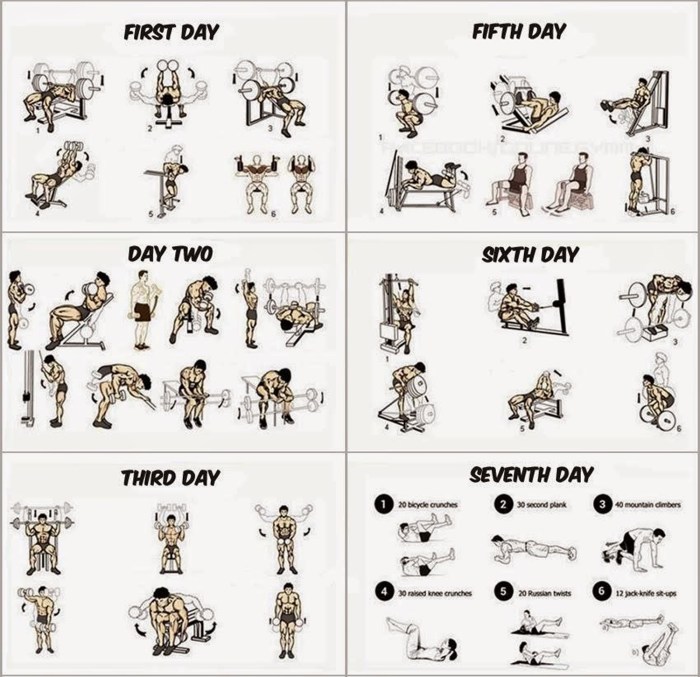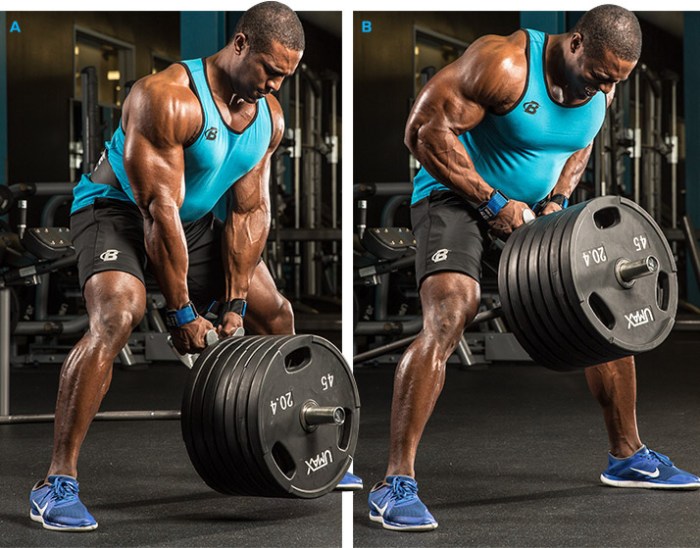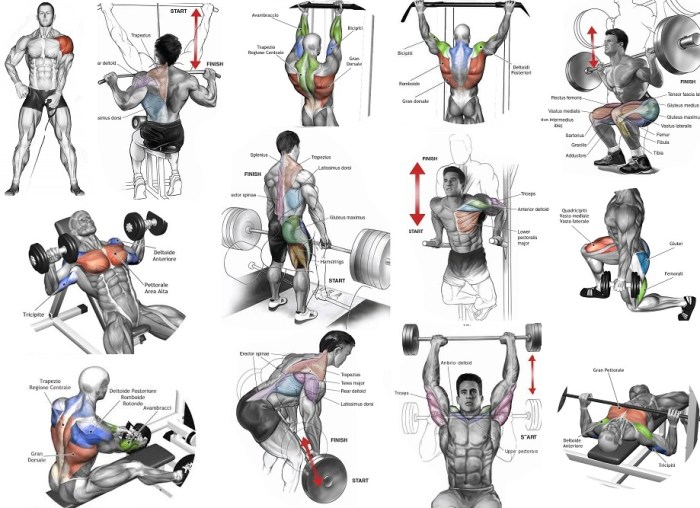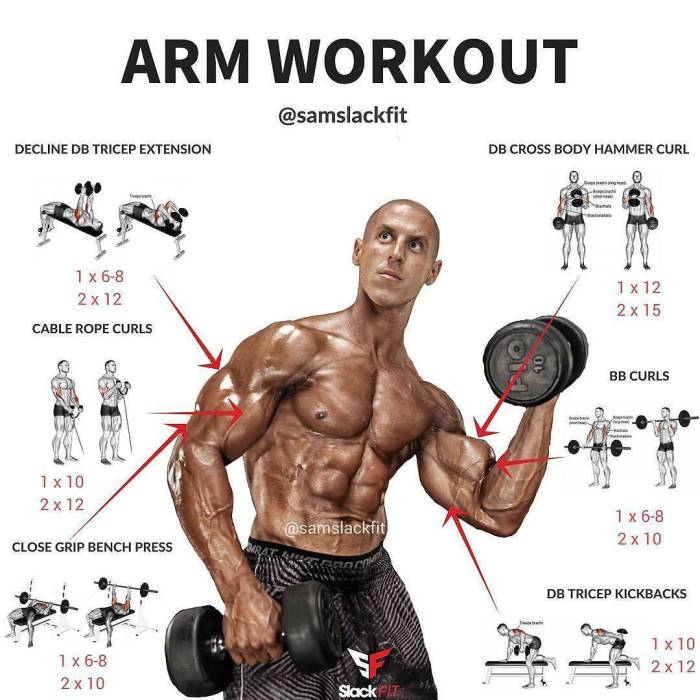Strength and muscle building workouts are essential for overall health and fitness, and this comprehensive guide will provide you with everything you need to know to get started. We’ll cover the principles of strength and muscle building, different types of workouts, exercises, nutrition, and more.
Whether you’re a beginner or an experienced lifter, this guide will help you achieve your strength and muscle building goals.
Overview of Strength and Muscle Building
Strength and muscle building are essential components of overall health and fitness. Strength refers to the ability to exert force against resistance, while muscle building involves increasing the size and strength of muscles.
Building strength and muscle offers numerous benefits, including improved physical performance, increased mobility and flexibility, reduced risk of injury, better posture, enhanced metabolism, and improved body composition.
Importance of Strength and Muscle Building
- Improved Physical Performance:Strength and muscle mass are crucial for activities like lifting, running, and jumping.
- Increased Mobility and Flexibility:Strong muscles support and stabilize joints, improving range of motion and reducing stiffness.
- Reduced Risk of Injury:Strong muscles protect joints and connective tissues, reducing the likelihood of strains, sprains, and other injuries.
- Better Posture:Strong back and core muscles help maintain proper posture, reducing back pain and improving overall alignment.
- Enhanced Metabolism:Muscle tissue is metabolically active, meaning it burns calories even at rest, contributing to weight management.
- Improved Body Composition:Building muscle increases lean body mass, which boosts metabolism and reduces body fat percentage.
Principles of Strength and Muscle Building
Understanding the principles of strength and muscle building is crucial for achieving optimal results in your fitness journey. These principles serve as the foundation for effective training and progress. By adhering to them, you can maximize muscle growth, enhance strength, and prevent injuries.
Progressive Overload
Progressive overload refers to the gradual increase in the intensity or volume of exercise over time. This principle challenges your muscles and forces them to adapt, leading to increased strength and muscle growth. You can achieve progressive overload by gradually increasing the weight you lift, the number of repetitions, or the frequency of your workouts.
Specificity
Specificity is the principle that dictates performing exercises that target specific muscle groups to promote their development. Different exercises activate different muscle fibers, so it’s important to incorporate a variety of exercises into your routine to ensure comprehensive muscle growth.
For instance, performing squats and leg presses will primarily target your quadriceps, while exercises like bicep curls and tricep extensions will focus on your arm muscles.
Recovery
Recovery is an essential aspect of strength and muscle building. Allowing adequate rest and sleep provides your body with the necessary time to repair and rebuild muscle tissue. During rest, your muscles synthesize protein, which is vital for muscle growth.
Aim for 7-9 hours of quality sleep each night and incorporate rest days into your training schedule to facilitate recovery.
Nutrition
Nutrition plays a pivotal role in muscle growth. Consuming a balanced diet with sufficient protein, carbohydrates, and healthy fats is essential for supporting muscle repair and growth. Protein provides the building blocks for muscle tissue, while carbohydrates supply energy for your workouts.
Healthy fats support hormone production and overall health. Aim for a protein intake of 1.6-2.2 grams per kilogram of body weight daily.
Hydration
Hydration is crucial for maintaining proper muscle function and overall health. Water helps transport nutrients to your muscles, lubricates your joints, and regulates body temperature. Dehydration can impair muscle performance and hinder recovery. Aim to drink plenty of water throughout the day, especially before, during, and after your workouts.
Proper Exercise Form and Technique
Proper exercise form and technique are paramount for maximizing muscle activation and preventing injuries. Using correct body mechanics ensures that you target the intended muscle groups and minimize the risk of strain or injury. Focus on maintaining proper posture, engaging your core, and controlling your movements throughout each exercise.
Types of Strength and Muscle Building Workouts
Strength and muscle building workouts can be categorized into different types based on the exercises used, the number of muscle groups targeted, and the overall workout structure. Understanding these types will help you design an effective workout plan that meets your specific goals.
Compound Exercises
Compound exercises involve multiple muscle groups in a single movement. These exercises are highly efficient and can help you build strength and muscle mass in a shorter amount of time. Examples of compound exercises include squats, deadlifts, bench press, overhead press, and pull-ups.
Isolation Exercises
Isolation exercises target a specific muscle group or joint. These exercises are used to develop muscle size and definition. Examples of isolation exercises include bicep curls, tricep extensions, leg extensions, and calf raises.
Full-Body Workouts
Full-body workouts target all major muscle groups in a single session. These workouts are ideal for building overall strength and muscle mass. Full-body workouts can be performed 2-3 times per week.
Exercises for Strength and Muscle Building
Building strength and muscle requires a well-rounded exercise regimen that targets different muscle groups and movement patterns. Here’s a comprehensive list of exercises to help you achieve your goals:
Compound Exercises
Compound exercises engage multiple muscle groups simultaneously, making them highly efficient for building strength and muscle mass. Examples include:
- Squats
- Deadlifts
- Bench press
- Overhead press
- Pull-ups
- Rows
Isolation Exercises
Isolation exercises focus on a single muscle group, allowing for targeted development. Examples include:
- Bicep curls
- Triceps extensions
- Leg extensions
- Hamstring curls
- Calf raises
Bodyweight Exercises
Bodyweight exercises utilize your own body as resistance, making them accessible and effective for building strength and muscle. Examples include:
- Push-ups
- Pull-ups
- Planks
- Lunges
- Burpees
Progressive Overload
To continuously challenge your muscles and promote growth, it’s essential to incorporate progressive overload into your training. This involves gradually increasing the weight, sets, or repetitions over time to continually stress your muscles and stimulate adaptation.
Workout Plan Design

Crafting effective workout plans for strength and muscle building requires a balanced approach to workout frequency, volume, and intensity. Understanding the interrelation between these factors is crucial for optimizing results.
Workout frequency refers to the number of times per week you train a specific muscle group. Volume, on the other hand, represents the total amount of work performed during a workout, measured in sets, repetitions, and weight lifted. Intensity signifies the effort level you put into each exercise, typically measured as a percentage of your one-repetition maximum (1RM).
Workout Frequency
The optimal workout frequency depends on your training goals, experience level, and recovery capacity. Beginners may start with 2-3 workouts per week, gradually increasing frequency as they progress. For experienced lifters, 3-5 workouts per week may be suitable.
Workout Volume
Volume is directly related to muscle growth and strength gains. A higher volume stimulates more muscle protein synthesis and muscle fiber recruitment. However, excessive volume can lead to overtraining and reduced results. Aim for 8-12 sets per muscle group per week.
Workout Intensity, Strength and muscle building workout
Intensity is crucial for overloading the muscles and triggering adaptations. Heavy weights (70-85% of 1RM) promote strength gains, while lighter weights (60-75% of 1RM) are more effective for hypertrophy. Use a mix of heavy and light weights to maximize results.
Nutrition for Strength and Muscle Building
Proper nutrition is crucial for supporting strength and muscle building. It provides the necessary building blocks for muscle growth and repair, and fuels the intense workouts required to achieve your goals.
Protein Intake
Protein is essential for muscle growth and recovery. Aim for 1.6-2.2 grams of protein per kilogram of body weight per day. This can be achieved through a combination of protein-rich foods and supplements.
Calorie Needs
To gain muscle, you need to consume more calories than you burn. Calculate your daily calorie needs using a calorie calculator and adjust your intake accordingly.
Nutrient Timing
Consuming protein and carbohydrates within 30-60 minutes after a workout can help maximize muscle growth and recovery.
Recommended Daily Macronutrient Intake
| Macronutrient | Percentage of Total Calories |
|---|---|
| Protein | 15-25% |
| Carbohydrates | 50-65% |
| Fat | 20-35% |
Nutrient-Rich Foods
- Lean meats (chicken, turkey, fish)
- Dairy products (milk, yogurt, cheese)
- Eggs
- Legumes (beans, lentils, chickpeas)
- Whole grains (brown rice, quinoa, oatmeal)
- Fruits
- Vegetables
Sample Meal Plan
Here’s a sample meal plan that incorporates the recommended nutrition guidelines:
- Breakfast: Oatmeal with berries and nuts
- Lunch: Grilled chicken salad with brown rice
- Dinner: Salmon with roasted vegetables and quinoa
- Snacks: Protein shake, fruit, yogurt
Hydration
Staying hydrated is essential for muscle function and recovery. Aim to drink 8-10 glasses of water per day, especially before, during, and after workouts.
Supplements
Supplements can be beneficial for supporting strength and muscle building, but they should not replace a balanced diet.
- Creatine: Enhances muscle energy and power
- BCAAs: Essential amino acids that promote muscle growth and recovery
- Protein powder: Convenient way to increase protein intake
Recovery: Essential for Muscle Growth and Repair
Recovery is a crucial yet often overlooked aspect of strength and muscle building. It’s during rest that your muscles repair and grow, making recovery just as important as the workout itself. Incorporating sufficient rest into your routine can enhance your results and prevent burnout.
Types of Recovery
There are three main types of recovery:
- Sleep:Aim for 7-9 hours of quality sleep each night. Sleep promotes hormone release, muscle recovery, and overall well-being.
- Rest Days:Schedule rest days into your workout plan to give your muscles time to recover. Active rest days, involving light activities like yoga or stretching, can aid recovery while promoting blood flow to muscles.
- Active Recovery:Engage in low-intensity activities like yoga, stretching, or light cardio on rest days. Active recovery enhances blood flow, reduces muscle soreness, and promotes flexibility.
Table: Benefits of Recovery Types
| Recovery Type | Benefits ||—|—|| Sleep | Hormone release, muscle recovery, cognitive function || Rest Days | Reduced muscle soreness, enhanced recovery || Active Recovery | Improved blood flow, reduced muscle soreness, increased flexibility |
“Adequate recovery is essential for optimal muscle growth and performance. Neglecting recovery can lead to overtraining, reduced gains, and increased risk of injury.”- American College of Sports Medicine
Tips for Optimizing Recovery
- Prioritize Sleep:Aim for 7-9 hours of quality sleep each night.
- Schedule Rest Days:Include 1-2 rest days per week.
- Engage in Active Recovery:Incorporate yoga, stretching, or light cardio into rest days.
- Listen to Your Body:If you’re feeling excessively fatigued or sore, take an extra rest day.
- Hydrate:Stay hydrated throughout the day to support muscle recovery.
- Consider Massage:Sports massage can help reduce muscle soreness and promote recovery.
Consequences of Insufficient Recovery
Inadequate recovery can lead to:
- Overtraining:Excessive training without sufficient rest can lead to burnout, decreased performance, and increased risk of injury.
- Injury:Insufficient recovery can weaken muscles and increase the likelihood of strains, sprains, and other injuries.
- Reduced Gains:Neglecting recovery can hinder muscle growth and strength development.
Supplements for Strength and Muscle Building

Supplements can play a role in supporting strength and muscle building, but it’s important to understand their potential benefits and limitations. Creatine, protein powder, and other supplements can provide additional nutrients or aid in recovery, but they should not replace a balanced diet and proper training.
Types of Supplements
Here are some common supplements used for strength and muscle building:
- Creatine:Helps increase muscle energy stores.
- Protein powder:Provides essential amino acids for muscle growth and repair.
- BCAAs:Essential amino acids that support muscle protein synthesis.
- Glutamine:May aid in muscle recovery and reduce muscle soreness.
- Beta-alanine:Buffers lactic acid production, reducing muscle fatigue.
- Caffeine:Stimulant that can improve focus and energy levels.
Benefits and Side Effects
The potential benefits and side effects of these supplements vary:
| Supplement | Benefits | Side Effects |
|---|---|---|
| Creatine | Increased muscle energy, strength, and power | Possible water retention, gastrointestinal issues |
| Protein powder | Supports muscle growth and repair | Potential for weight gain, kidney issues if consumed in excess |
| BCAAs | Enhanced muscle protein synthesis | May cause nausea or diarrhea if taken in high doses |
| Glutamine | Reduced muscle soreness, improved recovery | Limited evidence for effectiveness |
| Beta-alanine | Reduced muscle fatigue | Tingling sensation (paresthesia) |
| Caffeine | Improved focus and energy | Increased heart rate, anxiety, insomnia |
Tips for Safe and Effective Use
- Consult with a healthcare professional before using supplements.
- Follow recommended dosages and avoid excessive intake.
- Choose high-quality supplements from reputable brands.
- Monitor your body’s response and adjust usage accordingly.
- Do not rely solely on supplements; focus on a balanced diet and proper training.
Training Frequency and Intensity
Training frequency and intensity are two important factors to consider when designing a strength and muscle building workout plan. The optimal frequency and intensity will vary depending on your individual goals, fitness level, and recovery ability.
In general, it is recommended to train each muscle group 2-3 times per week with a frequency of 2-3 sets per exercise. The intensity of your workouts should be challenging enough to stimulate muscle growth, but not so intense that you are unable to recover properly.
Volume, Intensity, and Recovery
The relationship between volume, intensity, and recovery is important to understand when designing a strength and muscle building workout plan. Volume refers to the total amount of work you do in a workout, intensity refers to the difficulty of the exercises you are doing, and recovery refers to the amount of time you allow your muscles to rest and repair.
It is important to find a balance between volume, intensity, and recovery. Too much volume or intensity can lead to overtraining, which can result in muscle loss and decreased performance. Too little volume or intensity will not be enough to stimulate muscle growth.
Periodization for Strength and Muscle Building

Periodization is a structured approach to training that involves varying the volume, intensity, and exercises over time to optimize strength and muscle growth. It allows you to progressively overload your muscles, avoid plateaus, and reduce the risk of overtraining.
There are different periodization models, each with its benefits and applications. Some common models include:
Linear Periodization
This model gradually increases the weight or resistance used over time, while keeping the volume (sets and reps) relatively constant. It’s simple and effective for beginners, but can lead to plateaus over time.
Block Periodization
This model involves alternating periods of high-volume, low-intensity training with periods of low-volume, high-intensity training. It allows for greater recovery and helps break through plateaus.
Undulating Periodization
This model involves varying the volume and intensity on a daily or weekly basis. It keeps the training stimulus constantly changing, which can help prevent plateaus and promote continuous progress.
Tracking Progress
Tracking your progress in strength and muscle building is crucial for identifying areas for improvement, adjusting training programs, and staying motivated. Here are some effective methods for monitoring your gains:
1RM Testing:One-rep max (1RM) testing involves determining the maximum weight you can lift for a single repetition in an exercise. Regular 1RM testing helps assess strength gains over time and allows you to adjust your training weight accordingly.
Tracking Weight Lifted Over Time:Keep a training log or use an app to record the weight you lift in each workout. By tracking your progress over weeks and months, you can identify patterns and make adjustments to increase the weight gradually.
Measuring Body Composition:Measuring body composition using methods like calipers, DEXA (dual-energy X-ray absorptiometry), or bioelectrical impedance analysis provides insights into muscle mass, body fat percentage, and other important metrics. This information helps you assess the effectiveness of your training and nutrition plan.
Taking Progress Photos:Taking progress photos from the same angles and lighting conditions over time allows you to visually track changes in muscle definition and body composition. This can provide motivation and help you stay on track.
Monitoring your strength gains, body composition, and measurements enables you to:
- Identify areas where you’re progressing well and where you need to focus more.
- Adjust your training program based on your progress, increasing weight or intensity when appropriate.
- Stay motivated and on track by seeing the results of your efforts.
Using a training log or app to track your progress can streamline the process and provide valuable insights. These tools allow you to easily record workout data, monitor trends, and set realistic goals. By tracking your progress and making adjustments as needed, you can optimize your training and achieve your strength and muscle-building goals more effectively.
Common Mistakes in Strength and Muscle Building

Building strength and muscle is a rewarding journey, but it can be hindered by common mistakes. Identifying and addressing these pitfalls can optimize your progress and prevent setbacks.
One prevalent mistake is overtraining, pushing your body beyond its recovery capacity. Listen to your body and rest when needed. Improper form, compromising technique for weight, can lead to injuries and hinder muscle growth. Ensure you maintain proper form throughout your workouts.
Inadequate Nutrition
Neglecting proper nutrition can sabotage your strength and muscle-building efforts. Protein is essential for muscle repair and growth. Carbohydrates provide energy, and healthy fats support hormone production. A balanced diet that meets your caloric needs is crucial for optimal results.
Overcoming Plateaus
Reaching plateaus in strength and muscle building is a common experience that can be frustrating. These plateaus can occur for various reasons, including inadequate training, poor nutrition, insufficient rest, or a combination of these factors. Understanding the causes of plateaus and implementing effective strategies can help you break through these barriers and continue making progress towards your fitness goals.
Identifying the Type of Plateau
The first step in overcoming a plateau is to identify the type of plateau you are experiencing. There are three main types of plateaus:
- Strength Plateau:Inability to increase the weight you lift during exercises.
- Muscle Mass Plateau:Inability to gain additional muscle mass despite following a training and nutrition plan.
- Body Composition Plateau:Inability to lose body fat or gain muscle mass, resulting in a lack of progress in body composition.
Strategies for Overcoming Plateaus
Once you have identified the type of plateau you are experiencing, you can implement specific strategies to overcome it. These strategies include:
- Progressive Overload:Gradually increasing the weight, sets, reps, or intensity of your workouts to challenge your muscles and stimulate growth.
- Periodization:Varying your training routine by alternating between periods of high-intensity and low-intensity workouts to prevent stagnation.
- Changing Exercise Variations:Incorporating different exercises that target the same muscle groups from different angles to engage different muscle fibers.
- Nutritional Adjustments:Ensuring you are consuming adequate protein, carbohydrates, and healthy fats to support muscle growth and recovery.
- Adequate Rest and Recovery:Allowing your body sufficient time to rest and repair between workouts to facilitate muscle growth and prevent burnout.
Common Mistakes to Avoid
- Overtraining:Pushing your body too hard without allowing for adequate rest and recovery can lead to injuries and hinder progress.
- Insufficient Protein Intake:Protein is essential for muscle growth and repair. Not consuming enough protein can limit your ability to build muscle.
- Neglecting Rest and Recovery:Adequate rest is crucial for muscle growth and repair. Skipping rest days or not getting enough sleep can impair progress.
- Lack of Consistency:Inconsistent training and nutrition can hinder progress and make it difficult to overcome plateaus.
- Fear of Failure:Avoiding challenging workouts or increasing weight out of fear of failure can limit progress and prevent you from reaching your full potential.
Motivational Quote
“The only person you are destined to become is the person you decide to be.”- Ralph Waldo Emerson
Safety Considerations

Safety is paramount in strength and muscle building workouts. Neglecting proper form, warm-ups, and cool-downs can lead to injuries that hinder progress and jeopardize overall health.
Proper Form
- Maintain a neutral spine, keeping your back straight and avoiding excessive arching or rounding.
- Keep your core engaged throughout exercises to stabilize your body.
- Use a full range of motion, but avoid overextending or locking out joints.
Warm-Ups
- Begin with light cardio to elevate heart rate and prepare muscles for activity.
- Perform dynamic stretches that mimic the movements of the exercises you’ll be doing.
- Gradually increase the intensity of warm-ups to prepare your body for heavier weights.
Cool-Downs
- Perform static stretches to improve flexibility and reduce muscle soreness.
- Include light cardio to gradually lower heart rate and facilitate recovery.
- Cool-downs promote blood flow and prevent muscle stiffness.
Key Safety Guidelines
| Exercise | Key Safety Guidelines |
|---|---|
| Squats | – Keep your feet shoulder-width apart, toes slightly turned out.
|
| Bench Press | – Grip the bar slightly wider than shoulder-width.
|
| Deadlifts | – Stand with your feet hip-width apart, knees slightly bent.
|
Common Mistakes to Avoid
- Lifting too heavy without proper form.
- Neglecting warm-ups and cool-downs.
- Overtraining or ignoring rest days.
- Using momentum to lift weights.
- Ignoring pain or discomfort during exercises.
Listening to Your Body
Pay attention to how your body responds to workouts. If you experience pain, stop the exercise and consult a healthcare professional. Rest is essential for recovery and muscle growth. Listen to your body and take rest days when needed.
Case Studies and Success Stories
Strength and muscle building is a challenging but rewarding endeavor. Many individuals have achieved impressive results through dedication, consistency, and the application of sound principles. These case studies and success stories provide valuable insights into the methods and strategies used by individuals who have transformed their physiques and achieved their strength and muscle-building goals.
Real-Life Examples of Success
* Individual A:A 25-year-old male who gained 20 pounds of muscle in 12 months through a combination of progressive resistance training, a high-protein diet, and adequate rest.
Individual B
A 40-year-old female who lost 15 pounds of fat and gained 10 pounds of muscle in 8 months through a program that included circuit training, a calorie-controlled diet, and yoga.
Individual C
A 60-year-old male who improved his bench press by 50 pounds in 6 months through a combination of heavy lifting, targeted exercises, and nutritional supplementation.These individuals followed different paths to achieve their goals, but they all shared certain key principles:* Progressive Overload:Gradually increasing the weight, sets, or reps over time to challenge the muscles and promote growth.
Nutritional Support
Consuming sufficient protein, carbohydrates, and healthy fats to fuel workouts and support muscle recovery.
Adequate Rest
Allowing the body time to recover and rebuild after intense training sessions.These case studies provide inspiration and guidance for anyone seeking to improve their strength and muscle mass. By following the principles and methods Artikeld in these success stories, you can unlock your own potential and achieve your fitness goals.
Final Conclusion
Strength and muscle building workouts are an important part of a healthy lifestyle. By following the principles Artikeld in this guide, you can achieve your strength and muscle building goals and improve your overall health and fitness.
Commonly Asked Questions
What are the benefits of strength and muscle building workouts?
Strength and muscle building workouts offer a wide range of benefits, including increased strength, muscle mass, and bone density. They can also help improve your balance, coordination, and flexibility. Additionally, strength and muscle building workouts can help you burn fat, boost your metabolism, and reduce your risk of chronic diseases such as heart disease, stroke, and type 2 diabetes.
How often should I strength train?
The optimal frequency for strength training depends on your individual goals and fitness level. However, most experts recommend strength training 2-3 times per week.
What is the best way to get started with strength training?
If you’re new to strength training, it’s important to start slowly and gradually increase the intensity and frequency of your workouts over time. It’s also important to learn proper form for each exercise to avoid injury.
Leave a Reply